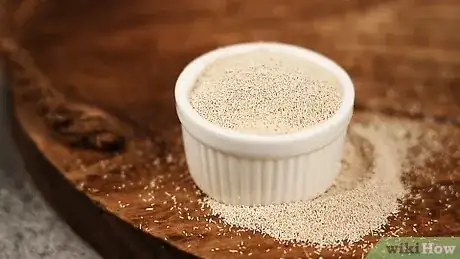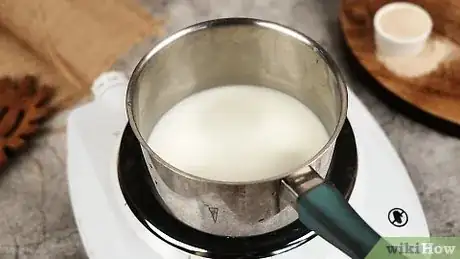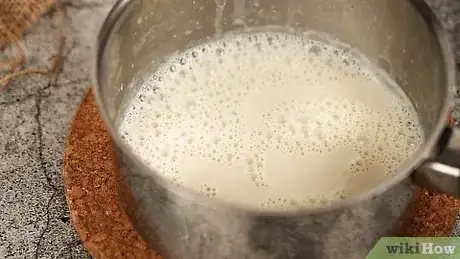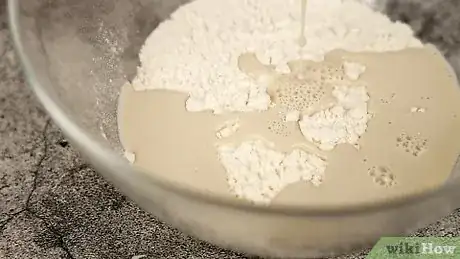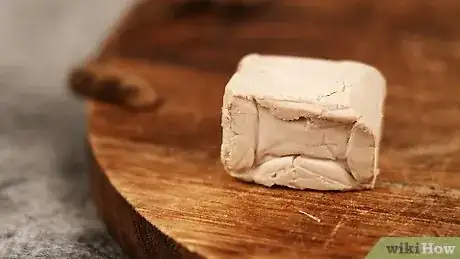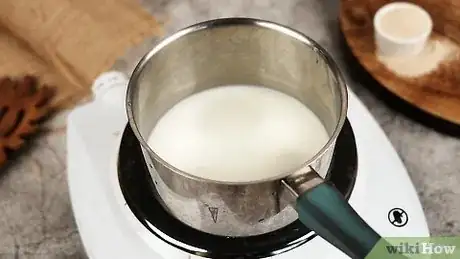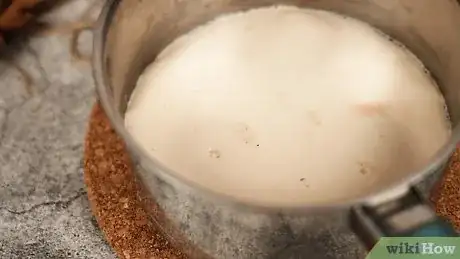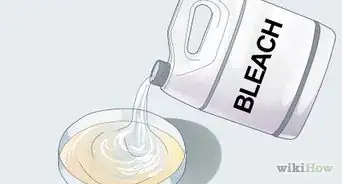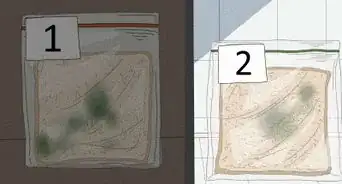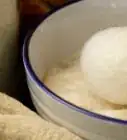This article was co-authored by Bess Ruff, MA. Bess Ruff is a Geography PhD student at Florida State University. She received her MA in Environmental Science and Management from the University of California, Santa Barbara in 2016. She has conducted survey work for marine spatial planning projects in the Caribbean and provided research support as a graduate fellow for the Sustainable Fisheries Group.
There are 9 references cited in this article, which can be found at the bottom of the page.
wikiHow marks an article as reader-approved once it receives enough positive feedback. In this case, several readers have written to tell us that this article was helpful to them, earning it our reader-approved status.
This article has been viewed 319,582 times.
Yeast, a microorganism that consumes sugars to produce carbon dioxide and alcohol, is an essential part of many baked and brewed products. "Blooming" or "proofing" is a simple process to test whether the yeast is alive and activate it quickly. Modern yeast-packaging techniques have made this process less necessary, but blooming is still a good idea for yeast that has been left on the shelf for a long time.[1]
Steps
Blooming Active Dry Yeast
-
1Skip this whole process when using instant yeast. Instant yeast or the smaller-grained "rapid-rise" yeast variety doesn't need to bloom, and can be added directly to the dry ingredients.[2] It is always active and has a long shelf life. Some professional bakers think instant yeast and active dry yeast produces a worse flavor compared to fresh yeast, but others detect no difference in the end result.
- Never use brewer's yeast, champagne yeast, or wine yeast for baking.
-
2Measure out a small amount of water or milk. Pour a small quantity of water or milk into a heat-safe container, writing down how much you use. The exact amount doesn't matter, but you should deduct this amount from the liquids in your recipe. 1/2 cup (120 mL) should be more than enough for a typical bread recipe.
- For instance, if you use 1/2 cup (120 mL) of water to bloom the yeast, and the recipe calls for 1 cup (240 mL) of water total, use 1/2 cup (120 mL) of water instead since you'll be mixing in the remaining 1/2 cup (120 mL) along with the yeast.
Advertisement -
3Warm the liquid. Warm the liquid to 105-110ºF (40–43ºC), which is warm but not hot or steaming. While yeast functions best at slightly lower temperatures, active dry yeast takes a little extra heat to get started.[3]
- If you don't own a food thermometer, warm the liquid to a lukewarm temperature, aiming low. A slightly cooler liquid will take longer to activate the yeast, but go too hot and the yeast will die and never activate at all.
-
4Mix in a teaspoon (5 mL) of sugar. Only warm water is necessary to activate the yeast, but the sugar allows you to test whether the yeast is ready. Active yeast will eat the sugar and produce carbon dioxide and other substances, which is exactly the process that makes bread dough rise and gives it a unique flavor. Stir in the sugar rapidly until it dissolves.[4]
- If you forget to add the sugar, you may add it after the yeast is already in the water. This is just as effective, but you should stir more gently to avoid spilling or damaging the yeast.
-
5Sprinkle yeast on top of the liquid. Measure out however much yeast the recipe calls for and sprinkle it onto the liquid. If the recipe calls for fresh yeast, use 1/2 that amount of active dry yeast instead, since dry yeast is more concentrated.[5] If the recipe calls for instant yeast, use 1.25 times that amount of active dry yeast instead.
- Note that some types of yeast expand when added to water. Transfer to a larger container if necessary to avoid spilling during this process.
-
6Stir the yeast in after 30 to 90 seconds. As the yeast sitting on the water's surface or slowly sinks, the water will dissolve the inactive yeast coating and free the active yeast in the center.[6] After allowing time for this to happen, stir the yeast gently into the water.
- These is no need to time this step precisely. It is unlikely the yeast will be affected by the stirring, even if you stir it in immediately.
-
7Wait 10 minutes, watching for bubbles or froth. If the yeast is alive and active, it will start consuming the sugar and releasing carbon dioxide, the gas that causes bread to rise. If the surface of the mixture becomes foamy or bubbly, the yeast is active and can be added to the other ingredients according to your recipe.[7]
- You may have to look closely for bubbles around the edge of the bowl.
- Other signs of activity may include a noticeable "yeasty" smell or an expanded volume, but these are not always noticeable.
- Unfortunately, if the mixture does not foam, the yeast is likely dead and cannot be used in recipes. You may wish to add some slightly warmed water, no hotter than 115ºF (43ºC), and let it sit an extra 10 minutes. If it has not foamed by this point, discard it.
-
8Add the liquid yeast mixture when the recipe calls for yeast. Add the liquid mixture containing the yeast when the recipe instructs you to add the yeast. Do not attempt to strain the yeast out.
Blooming Fresh Yeast
-
1Examine fresh yeast for problems. Fresh yeast refers to yeast stored in a slightly moist, packed-together form, which keeps it active but cannot preserve it for nearly as long as modern dry yeast packing methods. Be aware that fresh yeast likely won't survive freezing, and only lasts 1 or 2 weeks at room temperature, or 1 to 3 months at most in the refrigerator.[8] If it has become hard or turned dark brown, it is likely not usable. You may still test it by blooming to be sure, but it's wise to purchase additional backup yeast in advance so you do not have to interrupt your baking.
- Note: fresh yeast is also known as cake yeast, wet yeast, or compressed yeast.
- Never confuse liquid brewer's yeast with fresh baker's yeast. Only use baker's yeast (in any form) for baking.
-
2Measure a small amount of water or milk into a heat-safe container. Measure out 1/4 cup (60 mL) of a liquid called for in the recipe you plan to follow. You may use more if you need a lot of yeast, but make sure to note down how much you use so you can deduct this amount of liquid from the recipe.
- For example, if a recipe calls for 1 cup (240 mL) milk, and you use 1/4 cup (60 mL) milk to bloom the yeast, only add 3/4 cup (180 mL) milk in addition to the yeast mixture.
-
3Warm the liquid. Warm the liquid slightly to between 80-90ºF (27 – 32ºC), which is the temperature that encourages maximum yeast activity.[9] Fresh yeast is already active, not dormant like some dry yeast, so there is no need to warm the liquid further to "wake the yeast up."
- This temperature is only slightly warm. Steam or a skin forming on the milk means the liquid is far too hot and may kill the yeast.
- Because fresh yeast contains moisture already, you do not technically need additional water. Water is recommended in most cases, since room temperature may not be warm enough for the yeast to bloom. However, if the room is warm, you may simply mash together sugar and yeast.[10]
-
4Mix in teaspoon (5 mL) of sugar. Yeast feeds on almost any type of sugar, so mix in a small amount of white sugar, brown sugar, or anything natural and sweet. Artificial sweeteners cannot be used for blooming any type of yeast.
-
5Add yeast to the liquid. Gently stir in an amount of fresh yeast called for by the recipe. Because fresh yeast contains some liquid ingredients as well as yeast, you will need to adjust the amount used if the recipe calls for a different type of yeast:[11]
- If the recipe calls for active dry yeast, use twice as much fresh yeast as the amount listed.
- If the recipe calls for instant yeast, use 2.5 times as much fresh yeast.
-
6Wait a few minutes and watch for bubbles. If foam or bubbles form within 5 or 10 minutes, the yeast is alive and active, and the mixture can be added when the recipe calls for yeast. Otherwise, assuming the liquid wasn't too hot or cold, the yeast is likely dead and should be thrown away.[12]
- Because fresh yeast is kept active, it will likely not take as long to bloom as dry yeast.
Expert Q&A
Did you know you can get expert answers for this article?
Unlock expert answers by supporting wikiHow
-
QuestionI put the oil in with the sugar water and yeast. Is that ok?
 Bess Ruff, MABess Ruff is a Geography PhD student at Florida State University. She received her MA in Environmental Science and Management from the University of California, Santa Barbara in 2016. She has conducted survey work for marine spatial planning projects in the Caribbean and provided research support as a graduate fellow for the Sustainable Fisheries Group.
Bess Ruff, MABess Ruff is a Geography PhD student at Florida State University. She received her MA in Environmental Science and Management from the University of California, Santa Barbara in 2016. She has conducted survey work for marine spatial planning projects in the Caribbean and provided research support as a graduate fellow for the Sustainable Fisheries Group.
Environmental Scientist
-
QuestionWhen mixing my yeast, sugar and water together, when do I put the sugar in?
 Community AnswerThe yeast will eat the sugar whether it's dissolved in water or not, though the process may end up going faster if it is dissolved in your yeast water. You can mix them all in any order you like.
Community AnswerThe yeast will eat the sugar whether it's dissolved in water or not, though the process may end up going faster if it is dissolved in your yeast water. You can mix them all in any order you like.
Warnings
- Do not add yeast to water which feels ice-cold or hot to the touch. It may kill the yeast, or at least fail to activate it.⧼thumbs_response⧽
- Temperatures of under 50 degrees Fahrenheit (10ºC) will cause the yeast to go dormant, and temperatures over 140 degrees Fahrenheit (50ºC) will kill it.⧼thumbs_response⧽
- Salt can slow the activity of yeast, or even kill it in high concentrations.[14] Add any salt in the recipe to the other dry ingredients, not to the bowl of yeast mixture, even if the recipe instructs otherwise.⧼thumbs_response⧽
References
- ↑ http://www.thekitchn.com/baking-lessons-how-to-proof-ye-94555
- ↑ http://allrecipes.com/howto/yeast-the-basics/
- ↑ https://www.simplyrecipes.com/how-to-proof-yeast-5184517
- ↑ https://www.simplyrecipes.com/how-to-proof-yeast-5184517
- ↑ https://www.allrecipes.com/article/how-to-proof-yeast/
- ↑ http://www.thekitchn.com/baking-lessons-how-to-proof-ye-94555
- ↑ https://www.allrecipes.com/article/how-to-proof-yeast/
- ↑ http://www.eatbydate.com/other/baking/yeast/
- ↑ http://allrecipes.com/howto/yeast-the-basics/
- ↑ https://www.thekitchn.com/working-with-yeast-be-not-afra-72256
- ↑ https://www.simplyrecipes.com/how-to-proof-yeast-5184517#toc-how-to-proof-fresh-cake-yeast
- ↑ https://www.simplyrecipes.com/how-to-proof-yeast-5184517#toc-how-to-proof-fresh-cake-yeast
- ↑ http://www.education.com/science-fair/article/light-affect-yeast/
- ↑ http://www.reluctantgourmet.com/salt-does-kill-yeast/
About This Article
To bloom yeast, start by warming some water or milk on your stove. When the liquid is lukewarm, mix in 1 teaspoon of sugar until it dissolves. Then, sprinkle your yeast on top of the liquid. Wait about 1 minute so the liquid can dissolve the yeast’s coating and free the active yeast before you stir it up. Finally, watch your mixture for 10 minutes. If you see it becoming foamy or bubbly, the yeast is “alive” and can be used in your recipe. If you don’t see any activity, your yeast is probably “dead” and you’ll need to bloom a new batch to proceed. To learn how to get just the right temperature for blooming your yeast, read on!
